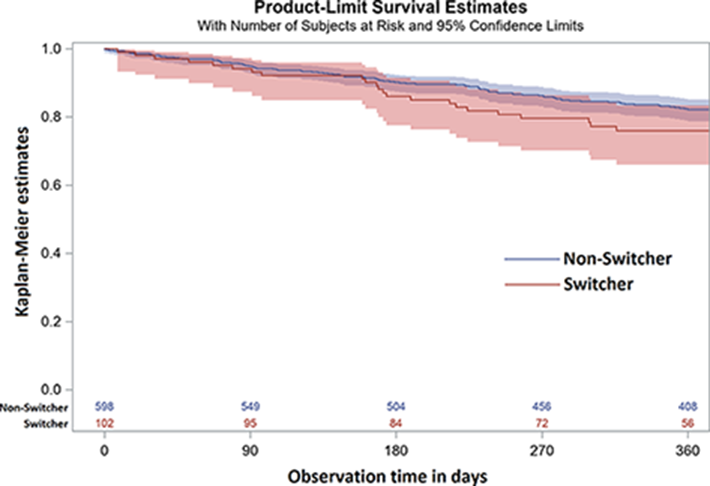

Background: In Germany, the first etanercept biosimilar was licensed in 2016. In contrast to other European countries there is no uniform recommendation for the prescription of biosimilars.
Objectives: To compare treatment survival between patients who were switched from the etanercept originator to the etanercept biosimilar SB4 and patients who stayed on the originator treatment.
Methods: We used data of rheumatoid arthritis patients observed in the prospective, longitudinal RABBIT ( R heumatoid A rthritis: O b servation of bi ologic t herapy) cohort until November 2018 who were treated with the etanercept originator (oETA) for at least six months. Patients who thereafter were switched to the biosimilar SB4 (bsETA) were matched (1:n) to patients who stayed on the original treatment using prescription time distribution matching [1] to control for survival bias. Matching criteria were sex, time of switch or corresponding duration of originator treatment in non-switchers and age as well as DAS28 at the time of switching or corresponding time point in non-switchers. The retention rates over one year were analyzed using Kaplan-Meier curves.
Results: Overall, 1,751 patients fulfilled the inclusion criteria of whom 113 were switched to bsETA. Of these, 102 switchers could be matched to 598 patients who remained on oETA. In both groups, 78% of the patients were female, mean age was about 59 years, DAS28 was 3.2 and physical function as well as numbers of prior biologics were similar. Patients who remained on oETA were more often rheumatoid factor positive (71% vs. 63%), had more erosions (56% vs. 47%) and had more frequently three or more comorbidities (34% vs. 28%) than those who were switched to bsETA. The most common reason for switching was costs (79%). After one year, 35% of the patients in both groups had stopped the respective treatment (oETA, n=210, bsETA, n=36). The main reasons for withdrawal were loss of efficacy (oETA: 57%, bsETA: 36%) and adverse events (oETA: 20%, bsETA: 42%). In both groups about the same portion of the adverse events that led to treatment discontinuation were serious events (24% vs. 27%). Kaplan-Meier curves showed similar retention rates over 12 months for bsETA and oETA (figure). Nine bsETA patients were switched back to oETA.
Conclusion: Retention rates of etanercept treated RA patients who were either switched to the biosimilar SB4 or who stayed on the originator are comparable. Only few patients switched back to the originator.
REFERENCE:
[1] Zhou Z, Rahme E, Abrahamowicz M, Pilote L. Survival bias associated with time-to-treatment initiation in drug effectiveness evaluation: a comparison of methods. Am J Epidemiol. 2005Nov15; 162(10):1016-1023.
Treatment continuation in etanercept patients who were either switched to the biosimilar SB4 or stayed on the originator.

Acknowledgement: Disclosure: RABBIT is supported by a joint, unconditional grant from AbbVie, Bristol-Myers Squibb, Celltrion, Hexal, Lilly, MSD Sharp & Dohme, Pfizer, Roche, Samsung Bioepis, Sanofi-Aventis und UCB.
Disclosure of Interests: Lisa Baganz: None declared, Anja Strangfeld Speakers bureau: Speakers fees from Bristol-Myers Squibb, MSD, Pfizer, Roche, Peter Herzer Speakers bureau: Pfizer, Andreas Krause Consultant for: Pfizer, Speakers bureau: Pfizer, Hans-Peter Tony Consultant for: Eli Lilly and Company, Speakers bureau: Eli Lilly and Company, Angela Zink Speakers bureau: Speakers fees from AbbVie, Janssen, Pfizer, Roche, Sanofi
DOI: 10.1136/annrheumdis-2019-eular.4026